Are you a bird enthusiast looking to discover the common birds in Wisconsin? Or do you have a feathered friend visiting your backyard feeder you need help identifying? Use this handy guide to discover all types of birds in Wisconsin, including small, large, and different-colored birds.
Small Birds of Wisconsin
Here are several common small birds in Wisconsin. Discover where they live and their distinguishing features.
Black-Capped Chickadee
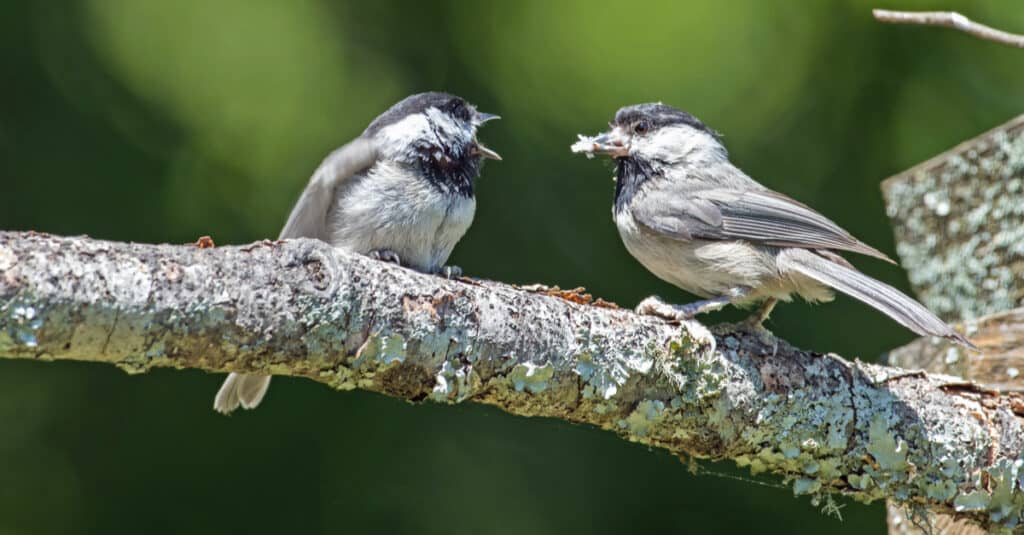
Black-Capped Chickadees
get their name from the slick black patch of feathers on their heads.
©Tom Franks/Shutterstock.com
The black-capped chickadee is a small, nonmigratory passerine bird native to the deciduous and mixed forests of North America. They get their name from the slick black patch of feathers on their heads. Its back and tail are slate greys, and its undersides and cheeks are white. They also have short, dark bills, long tails, and short, rounded wings. This chickadee is a year-round resident of Wisconsin and a popular visitor to backyard feeders./
House Finch
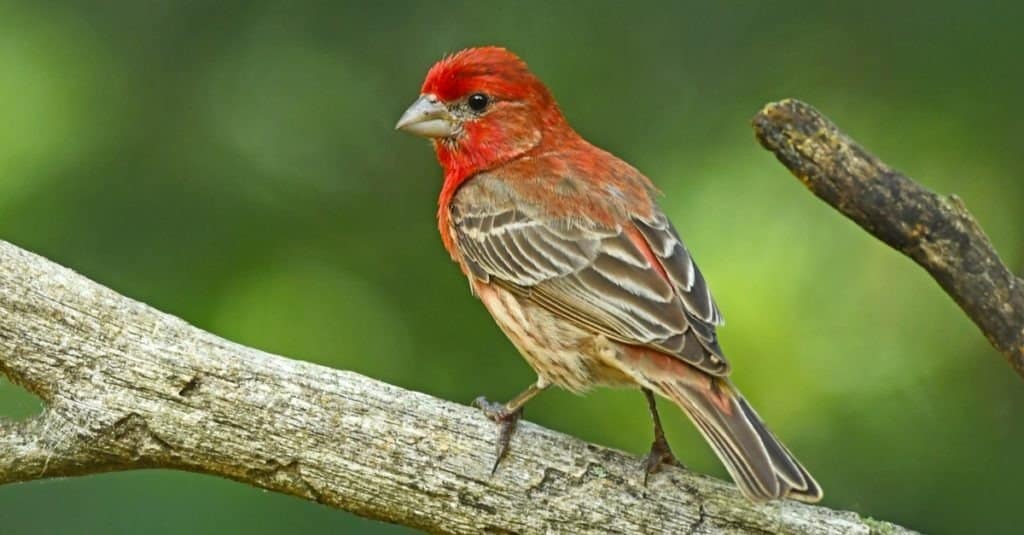
The
house finch’s
head, neck, and shoulders are reddish, and the color slowly fades into its chest and undersides.
©Brian A Wolf/Shutterstock.com
The house finch is a small passerine but a relatively moderately-sized finch. Their backs and tails are brown, fading into grey wings. Their heads, necks, and shoulders are reddish, and the color slowly fades into their chests and undersides. However, the color can vary depending on the bird’s diet. Diets heavy in berries and fruits result in a darker red color. These birds also reside in Wisconsin year-round. Look for them around suburban areas, such as backyards and parks.
White-Breasted Nuthatch
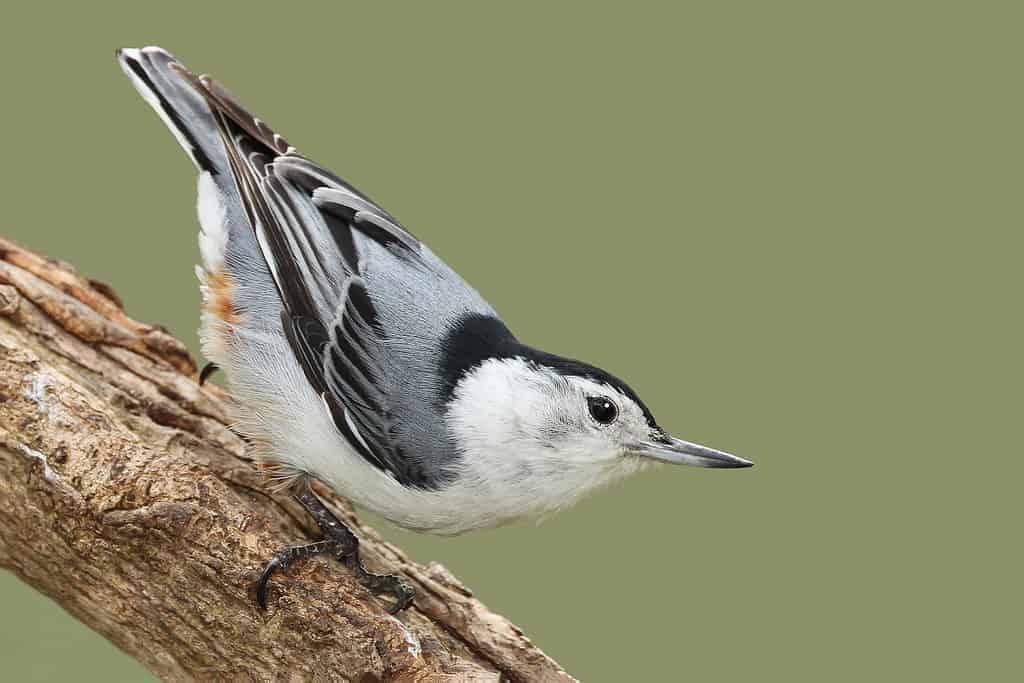
The white-Breasted
Nuthatch
typically has light bluish-grey upper parts and white undersides with a rusty red tinge on its lower abdomen.
©Brian Lasenby/Shutterstock.com
The white-breasted bird is a medium-sized nuthatch, and the coloration depends on its range. They typically have light bluish-grey upper parts and white undersides with a rusty red tinge on their lower abdomen. Males have black crowns, and females have grey. These birds are common and widespread throughout Wisconsin year-round. Look for them in forests, groves, woodlots, and suburban backyards.
House Sparrow
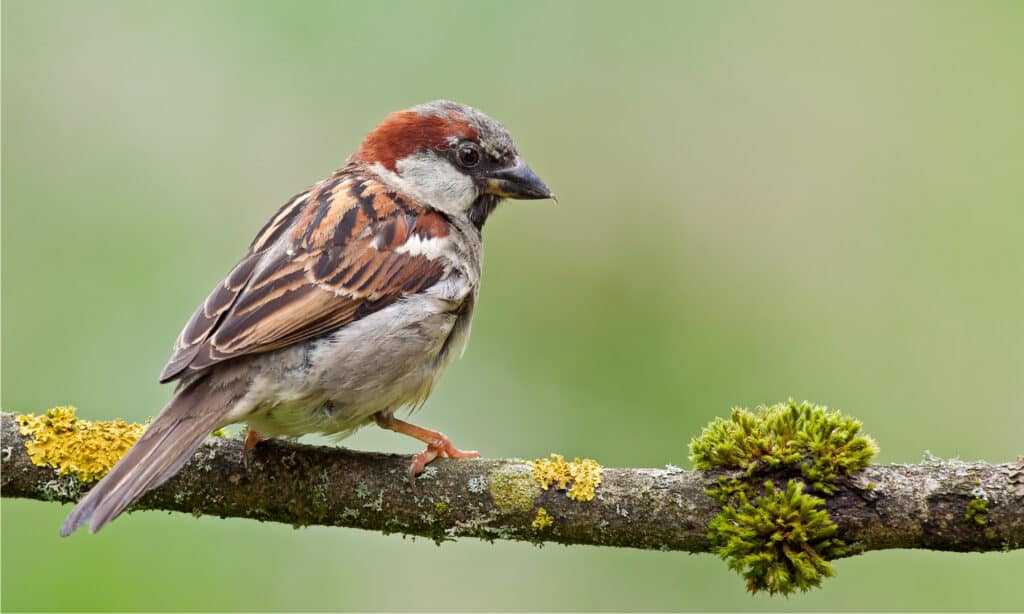
House Sparrows
are an introduced species to Wisconsin, but you can find them in the state year-round.
©Rob Christiaans/Shutterstock.com
The house sparrow is another small passerine bird found throughout much of the world. Adult males have reddish-brown crowns, backs, and wings with heavy black streaks. They have pale grey undersides and black face markings. Females look similar but feature duller colors and are less streaked with black. These birds are an introduced species to Wisconsin, but you can find them in the state year-round. Look for them in suburbs, farms, and urban areas.
Downy Woodpecker
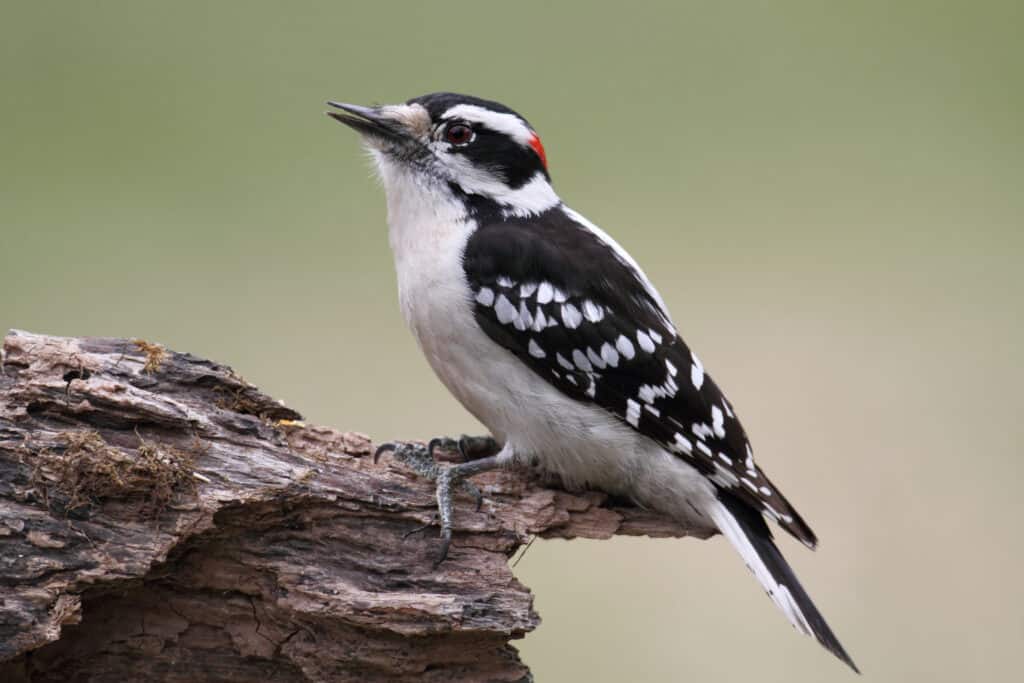
This species looks similar to the
hairy woodpecker
in Wisconsin, but downy woodpeckers are more likely to stop at bird feeders.
©Steve Byland/Shutterstock.com
Downy woodpeckers are the smallest species in North America, ranging from five to seven inches. This species is easy to distinguish due to its bold patterns. Their upper parts are primarily black with white marks, and their undersides are white. Their faces are white with black streaks, and males have red patches on the backs of their heads. This species looks similar to the hairy woodpecker in Wisconsin, but downy woodpeckers are more likely to stop at bird feeders. You can also find them in open woodlands, parks, and orchards.
Large Birds of Prey in Wisconsin
Discover the large birds of Wisconsin, including the most common hawks, owls, and other raptors.
Red-Tailed Hawk
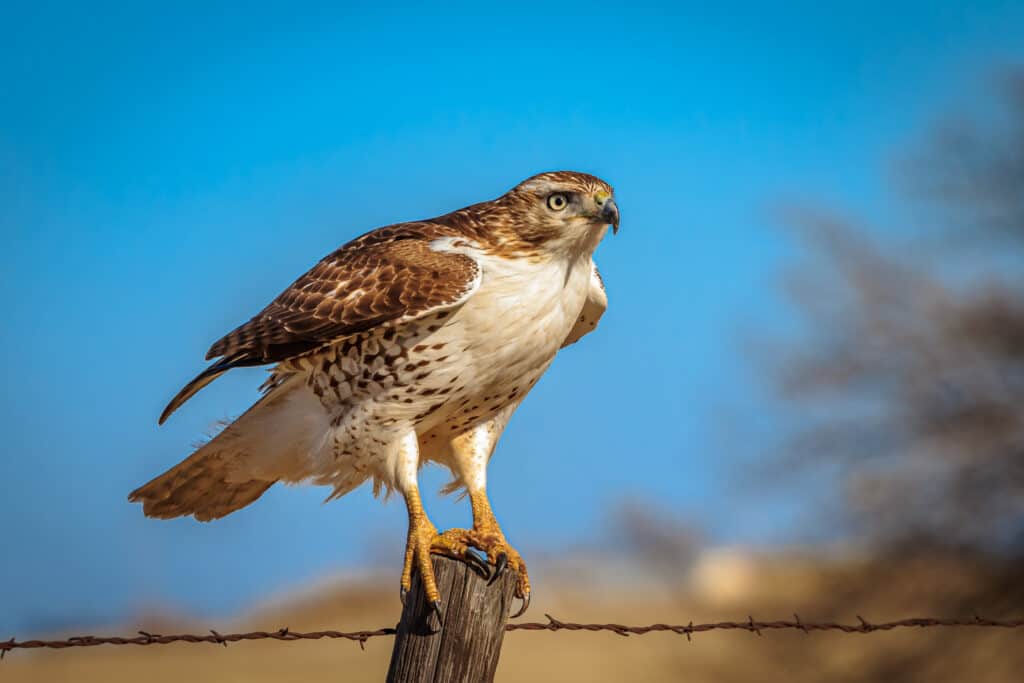
Red-tailed hawks are often seen near grasslands and prairies, but they adapt well to
humans
and can inhabit areas near parks and roadsides.
©Richard G Smith/Shutterstock.com
Red-tailed hawks are one of the most common hawks throughout North and South America. Its appearance varies between subspecies and regions, but most are dark brown above with horizontal streaks and white below. Their tails are brick red above and have a buff-orange color on the underside. Red-tailed hawks are often seen near grasslands and prairies, but they adapt well to humans and can inhabit areas near parks and roadsides.
Osprey

Ospreys have an excellent vision that can detect underwater objects from the air, and they catch
fish
by diving underwater, either foot first or by submerging their whole bodies.
©BlueBarronPhoto/Shutterstock.com
Ospreys are large raptors, also known as sea hawks, with a global range. These stately birds have brown backs and wings and greyish-white undersides and heads. They also have bright yellow irises. These birds are on Wisconsin’s endangered species list, making them relatively rare to spot in the wild. Osprey spends their summers in the state, with only a handful of nesting pairs reported. You can find them near large reservoirs in northern and central Wisconsin.
Great-Horned Owl
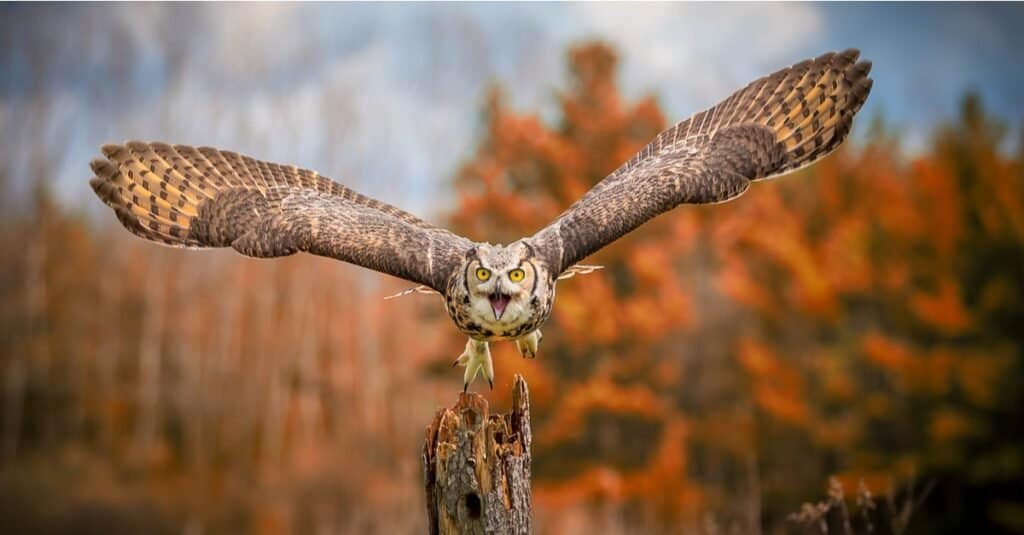
Great Horned Owls are one of the most dangerous birds because of their talons, sharp curved beak, and aggressive way of hunting.
©Imran Ashraf/Shutterstock.com
The great horned owl is a large owl native to the Americas, where it is widely distributed and highly adaptable. This species is a mottled brown with heavy dark markings and some light horizontal barring. They also have white patches on their throats and grey or brown facial discs. They are the largest and most common owl species in Wisconsin, and you can typically find them in woodlands, cliffs, and canyons.
Snowy Owl
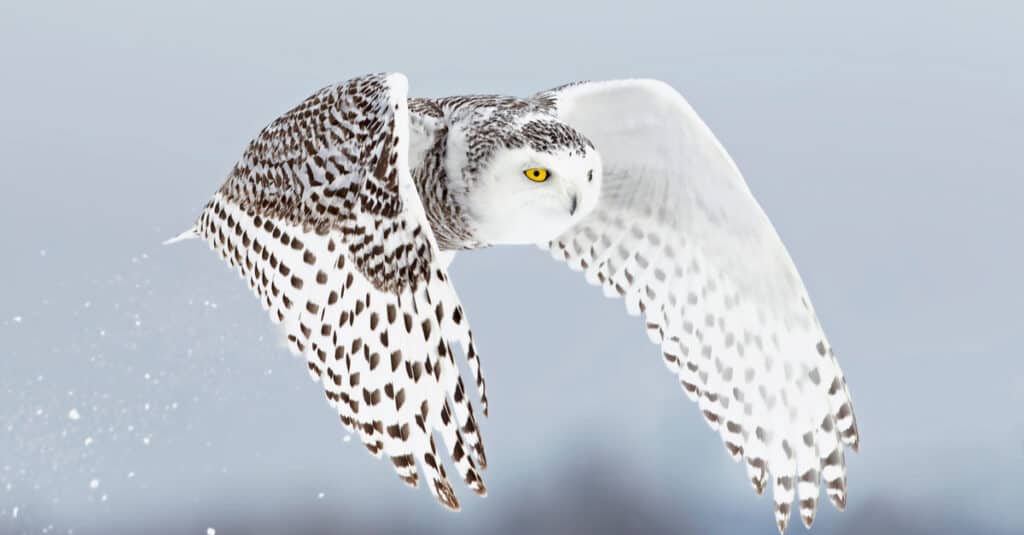
Snowy owls
are native to North America’s Arctic regions and typically breed on the tundra.
©Jim Cumming/Shutterstock.com
The snowy owl is another large species from the true owl family. They are native to North America’s Arctic regions and typically breed on the tundra. But some populations migrate south in the northern United States during the winter. Wisconsin sees an “irruption” of snowy owls every few years, and you can find them in fields, marshes, and prairies. Look for their brilliant white plumage with dark horizontal markings.
Yellow Birds in Wisconsin
Yellow birds are difficult to ignore. Their bright plumage brightens your backyard and reminds you of spring. Learn more about the most familiar yellow birds in Wisconsin.
American Goldfinch
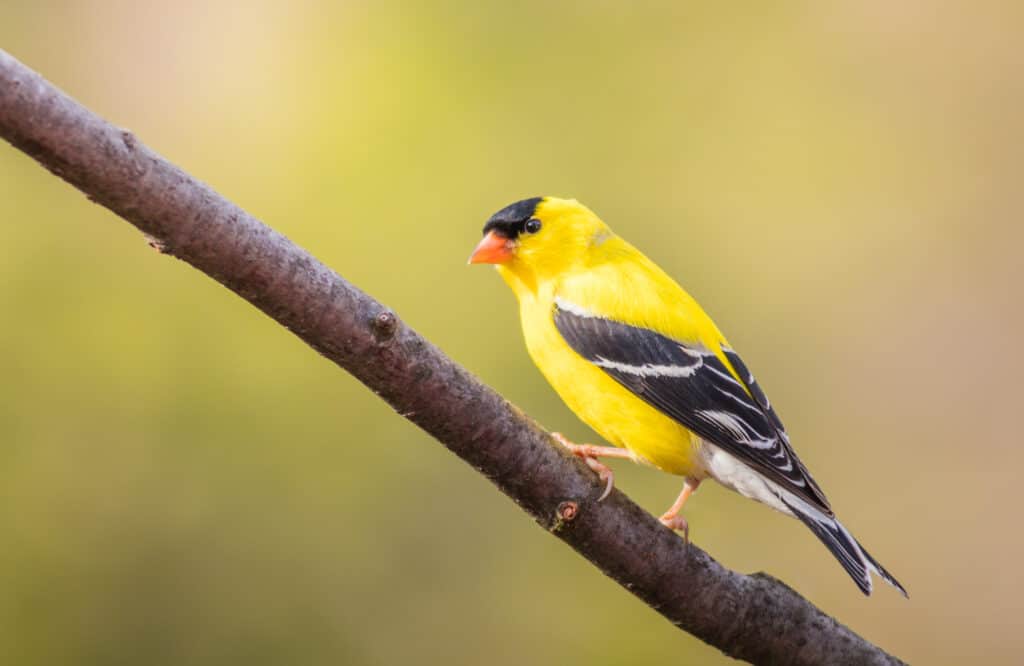
The American goldfinch lives in residential areas,
eating from bird
feeders, which increases its survival rate.
©Rabbitti/Shutterstock.com
The American goldfinch is a small yellow bird native to North America that benefits from human activity. They live in residential areas, eating from bird feeders, which increases their survival rate. Adult males are vibrant yellow during summers but molt into an olive green during winter. Females are a duller yellow-brown and only molt into slightly brighter colors during the warmer months.
Magnolia Warbler
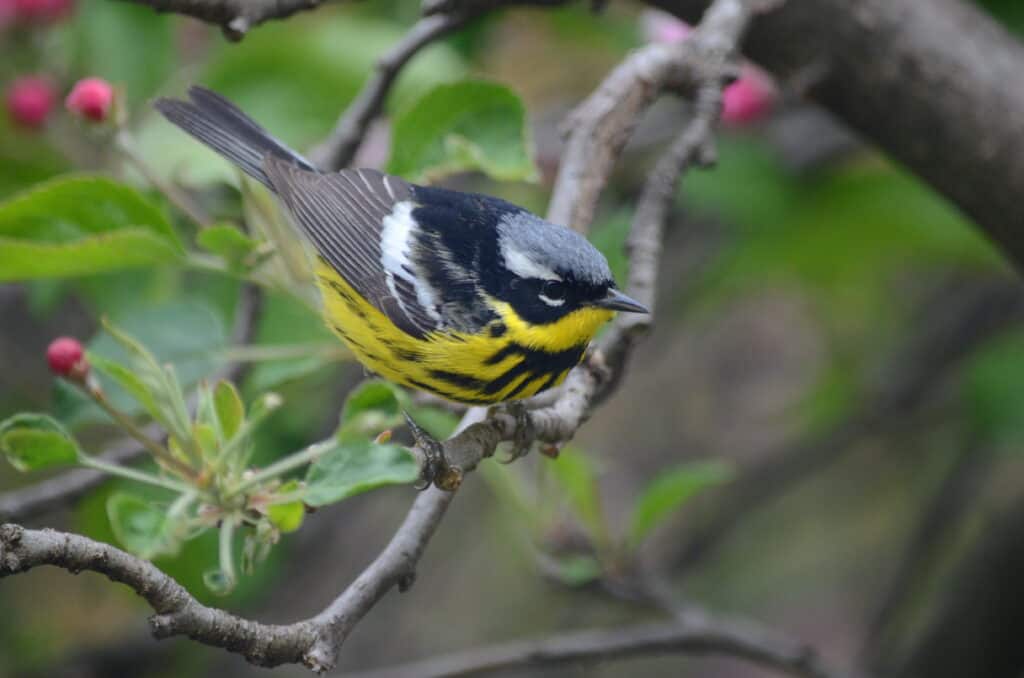
Adult male
magnolia warblers
are gray and black on top with white wing patches and yellow bellies.
©Bob Hilscher/Shutterstock.com
These small New world warblers breed in Canada, the midwestern and northeastern United States, and winter in Mexico and Central America. Magnolia warblers are easy to spot as they stay low in trees and inhabit various forest habitats in northern Wisconsin. Breeding males have white, grey, and black backs with yellow on their sides, and females share the same colors except more dull.
Evening Grosbeak
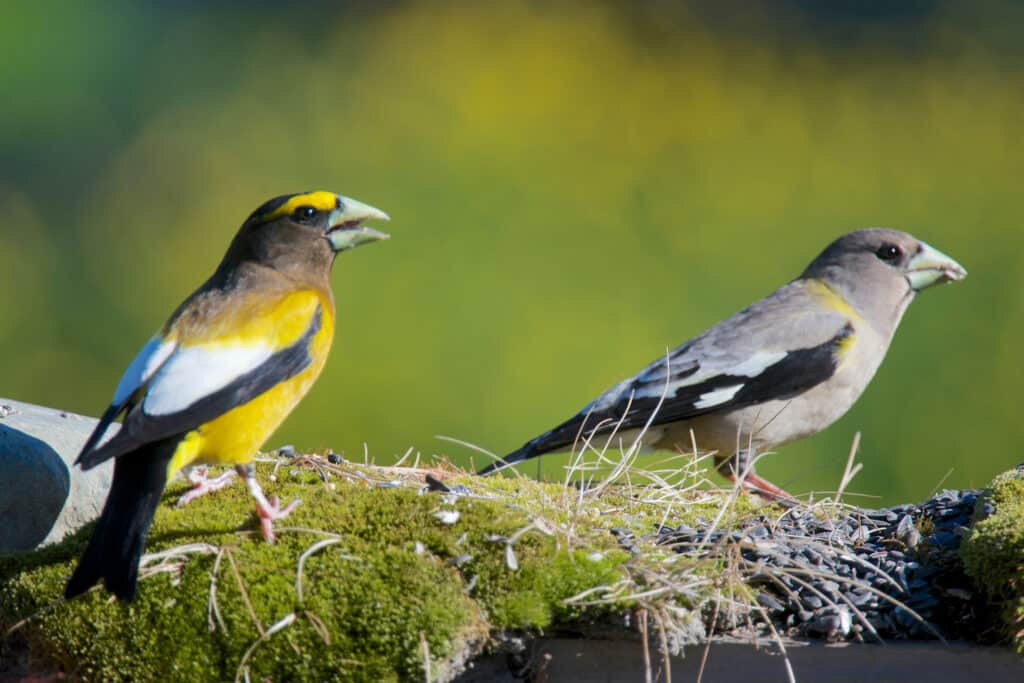
Researchers are unsure what’s causing a significant decline in the
evening grosbeak
population.
©Danita Delimont/Shutterstock.com
Evening grosbeaks are heavy-set passerine birds from the finch family. They are native to North America, living year-round in Canada and the eastern United States. But they also winter in the northern midwest and northeastern United States. This species breeds in northern Wisconsin counties in coniferous forests. Adult males have black tails, black wings, yellow foreheads, yellow bodies, and large white patches in their wings.
Blue Birds in Wisconsin
Blue birds are synonymous with bringing calm, peace, and serenity into your life. Here are some common blue birds in Wisconsin.
Blue Jay

Blue jays
live in forested habitats in most Wisconsin counties.
©iStock.com/BrianEKushner
The blue jay is a passerine bird that belongs to the Corvid family, which encompasses crows and ravens. These familiar birds are found throughout North America, where they inhabit southeastern Canada and the eastern half of the United States year-round. Blue jays live in forested habitats in most Wisconsin counties. Their plumage is sky-blue to mid-blue on their backs, wings, and tails; their faces are white. They also feature strong black bars on their wings and tails and a black neck collar.
Indigo Bunting
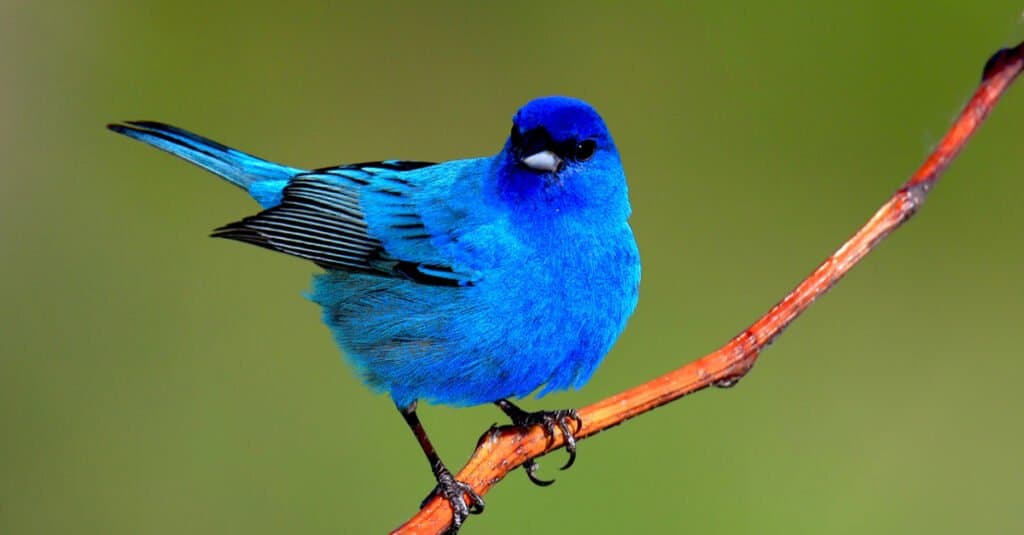
Indigo buntings
live in the whole state of Wisconsin during the summer breeding season, and you can find them in forest edge habitats.
©John L. Absher/Shutterstock.com
Indigo buntings are small colorful birds from the cardinal family. They breed throughout most of the United State’s eastern half and winter in Mexico and Central America. They live in the whole state of Wisconsin during the summer breeding season, and you can find them in forest edge habitats. These birds feature cerulean-colored bodies and brilliant indigo heads.
Tree Swallow
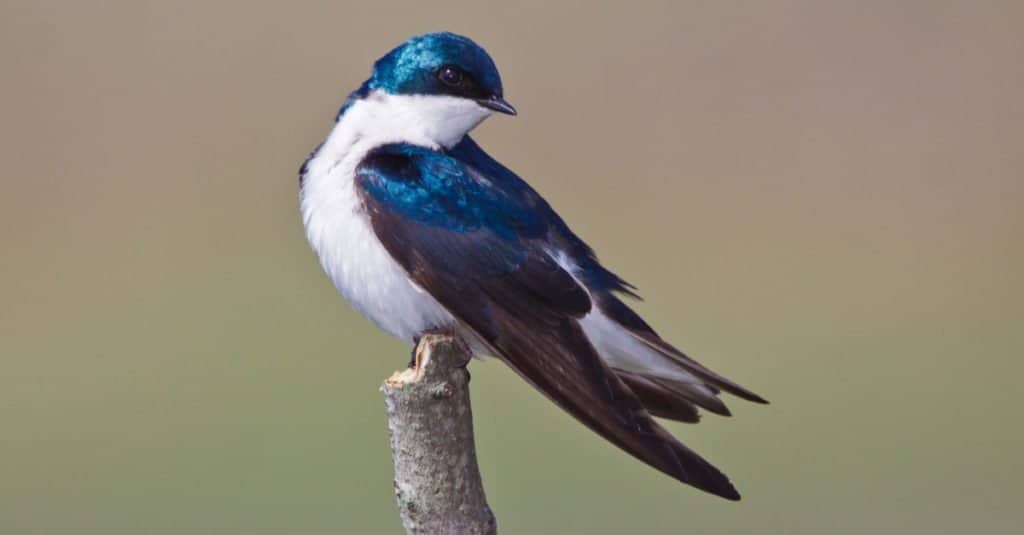
Tree Swallow
are common in open country areas near water in Wisconsin.
©Elliotte Rusty Harold/Shutterstock.com
Tree swallows are migratory birds native to the Americas. They breed in Canada, Alaska, and the northern half of the United States; they winter in the southern US, Mexico, and Central America. These birds are common in open country areas near water in Wisconsin. This species is a more subtle blue, with males featuring blue-green upper parts, white underparts, and black wings and tails. Females are similar in appearance but have a duller color and brown patches on their foreheads.
Red Birds in Wisconsin
Do you see a flash of crimson in your yard? Discover the top three red birds in Wisconsin.
Northern Cardinal

The
northern cardinal
is common throughout the year in Wisconsin, inhabiting brushy and semi-open habitats.
©Rob Palmer Photography/Shutterstock.com
The northern cardinal is a mid-sized songbird native to North America. They live year-round in the southwestern and eastern half of the United States and Mexico. This red bird is common throughout the year in Wisconsin, inhabiting brushy and semi-open habitats. The northern cardinal comes to mind when people think of a red bird. Males are a beautiful crimson red with black face masks, and females are more fawn-colored with greyish-brown hues.
Scarlet Tanager
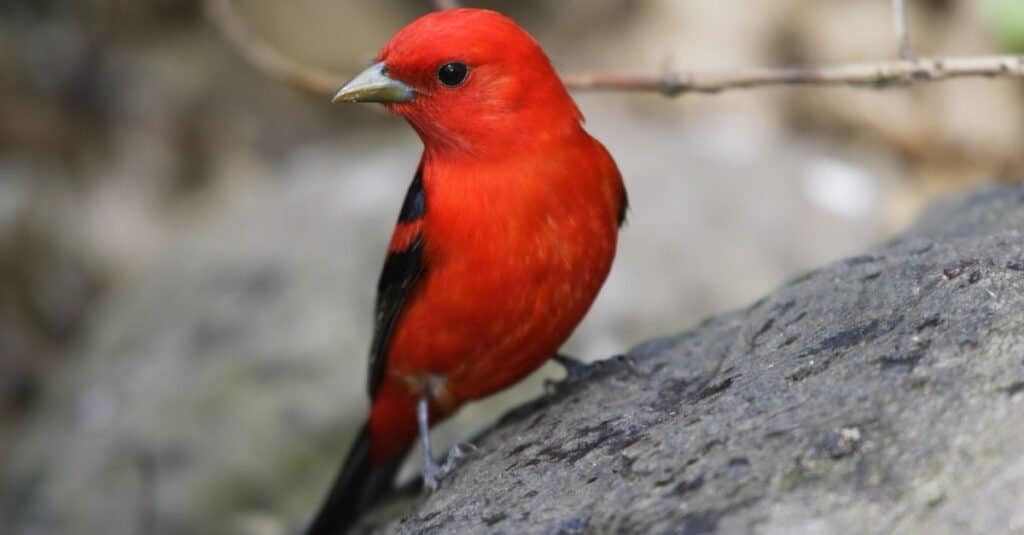
The
Scarlet Tanager
is arguably one of the most beautiful birds in Wisconsin
©Stubblefield Photography/Shutterstock.com
Scarlet tanagers are another medium-sized American songbird. They breed in the northeastern United States, migrate along the East Coast, and winter in Central America and South America. This species is arguably one of the most beautiful birds in Wisconsin and can be found throughout the state’s woodlands during warmer months. The adult male’s summer plumage is a deep crimson red with black wings and tails.
American Robin
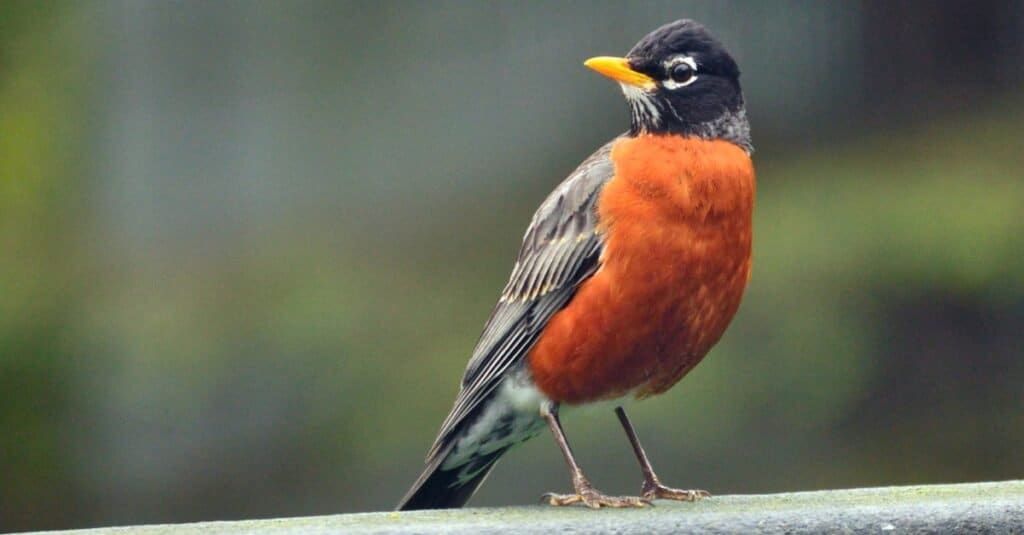
The male
American robin
is generally the last bird heard singing at sunset.
©iStock.com/PhotosByMSA
American robins are true thrust migratory birds and are Wisconsin’s official state bird. This species is widespread, breeding in Canada and Alaska, wintering in Mexico and Central America, and living year-round in the United States. They breed in Wisconsin and are often associated with the first signs of spring. Adults have blackish-grey heads, backs, wings, tails, yellow bills, and reddish-brown breasts.
Up Next:
- Animals in Wisconsin
- Types of Birds in Michigan
- Discover the 8 Types of Hawks in Wisconsin
- Wisconsin’s 10 Best Bird-Watching Spots This Summer
The photo featured at the top of this post is © Rabbitti/Shutterstock.com
Sources
- International Union for Conservation of Nature and Natural Resources, Available here: https://www.iucnredlist.org/
- Cornell University, Available here: https://www.birds.cornell.edu/home/
Thank you for reading! Have some feedback for us? Contact the AZ Animals editorial team.






